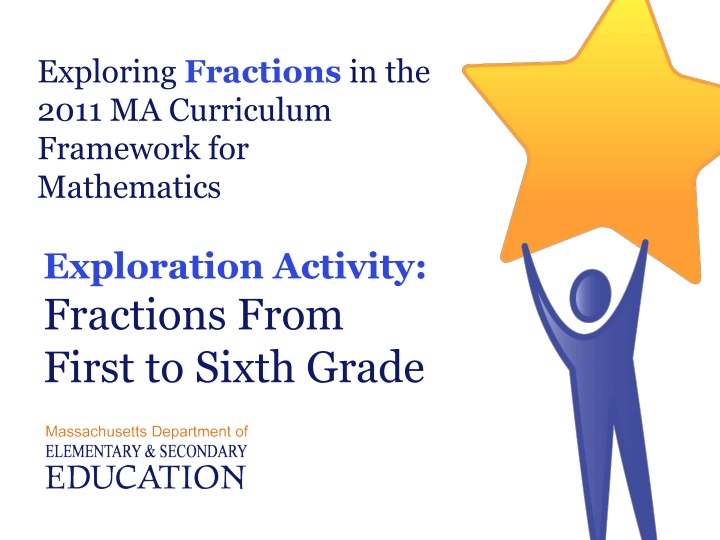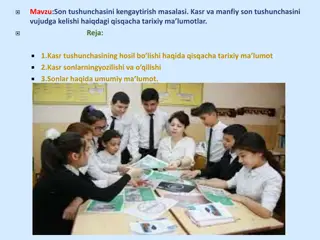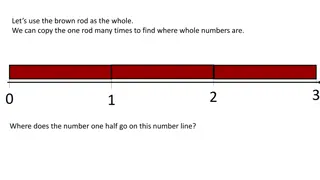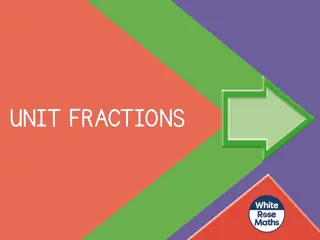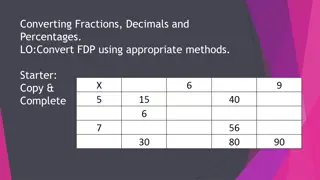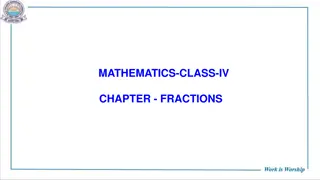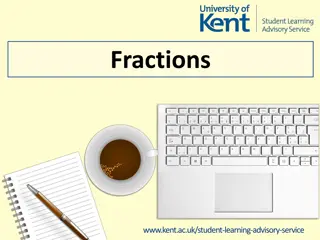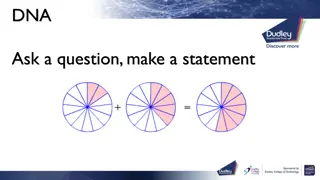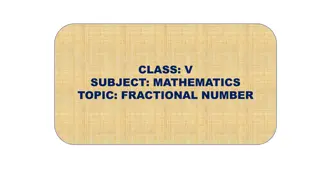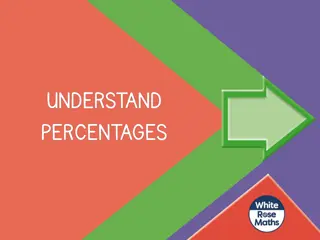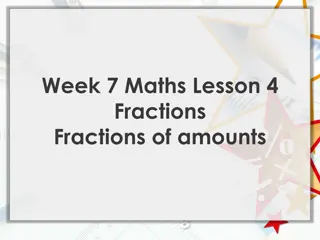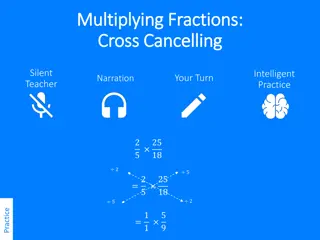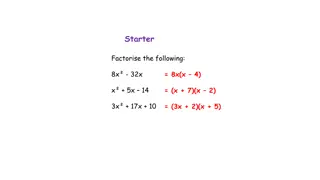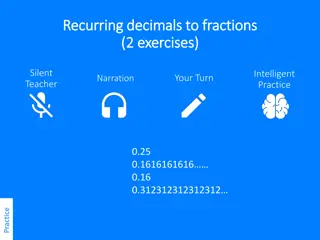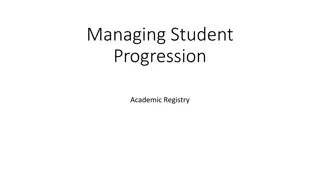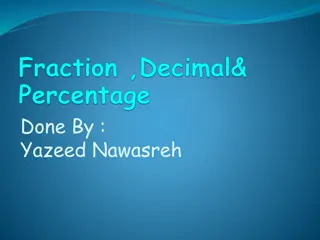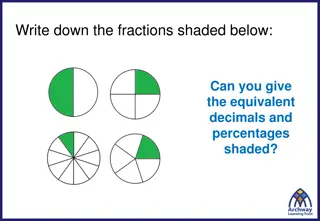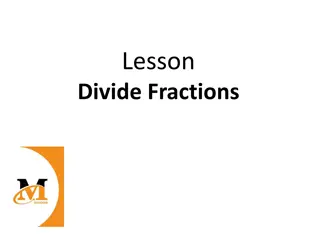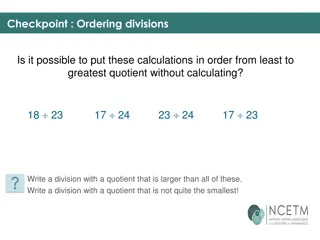Fractions Progression in 2011 MA Curriculum
The exploration of fractions in the 2011 Mathematics Curriculum Framework in Massachusetts showcases shifts in conceptual knowledge of fractions across grade levels. The progression from grades 1 to 6 emphasizes key shifts and the development of understanding fractions, ratios, and proportional relationships. This session delves into how the curriculum enhances fraction concepts through activities and problem-solving tasks, ultimately aiding in students' mastery of fractional concepts.
Download Presentation

Please find below an Image/Link to download the presentation.
The content on the website is provided AS IS for your information and personal use only. It may not be sold, licensed, or shared on other websites without obtaining consent from the author.If you encounter any issues during the download, it is possible that the publisher has removed the file from their server.
You are allowed to download the files provided on this website for personal or commercial use, subject to the condition that they are used lawfully. All files are the property of their respective owners.
The content on the website is provided AS IS for your information and personal use only. It may not be sold, licensed, or shared on other websites without obtaining consent from the author.
E N D
Presentation Transcript
Exploring Fractions in the 2011 MA Curriculum Framework for Mathematics Exploration Activity: Fractions From First to Sixth Grade
Session Goal We will explore: how the shifts in the 2011 Mathematics Curriculum Frameworks help to build conceptual knowledge of fractions how these fraction concepts progress through the grades. 2 Massachusetts Department of Elementary and Secondary Education
Session Overview I. Setting the Context: Fraction Math Problem II. Key Shifts and the Fractions Progression III.Fractions Progression: A. Grades 1and 2: Partition Shapes B. Grade 3-5: Fraction are Critical Areas C. Grade 6: Dividing Fractions by Fractions Connecting Fractions to Ratios and Proportional Relationships 3 Massachusetts Department of Elementary and Secondary Education
Setting the Context How many 1/3 cup servings are in 2 cups of raisins? 4 5.NF.7.c., page 51, Massachusetts Curriculum Framework for Mathematics, March 2011
Setting the Context How many 1/3 cup servings are in 2 cups of raisins? 2 cups 1/3 1/3 1/3 1 cup 1/3 1/3 1/3 5 5.NF.7.c., page 51, MP.2, p. 15 Massachusetts Curriculum Framework for Mathematics, March 2011
Setting the Context How many 1/3 cup servings are in 2 cups of raisins? 2 1/3 = 6 servings 2 cups 1/3 1/3 1/3 1 cup 1/3 1/3 1/3 6 5.NF.7.c., page 51, Massachusetts Curriculum Framework for Mathematics, March 2011
II. Key Shifts and the Fractions Progression 7 Massachusetts Department of Elementary and Secondary Education
The Progression: Fractions to Ratios and Proportional Reasoning Exploring the key shifts in this progression: Focus: fractions are identified as Critical Areas in grades 3-5 Coherence: fraction concepts build from grades 1-6 Clarity: precise language, specifying use of a variety of types visual models Rigor: visual representations to support conceptual understanding ongoing development of the Standards for Mathematical Practice 8 Massachusetts Department of Elementary and Secondary Education
Domain Progression in the 2011 MA Math Frameworks PK-8 Domains Progression Domains PK K 1 2 3 4 5 6 7 8 Counting and Cardinality MA Operations and Algebraic Thinking MA Number and Operations in Base Ten Number and Operations - Fractions Ratios and Proportional Relationships The Number System MA Expressions and Equations Functions Measurement and Data MA Geometry MA Statistics and Probability Coherence Exploration http://www.doe.mass.edu/candi/commoncore/mathexplore/
Fractions Progression and the Standards for Mathematical Practice Visual representations and modeling help students: Understand Communicate Problem Solve 10 Massachusetts Department of Elementary and Secondary Education
Visual Models in the New Standards, an Example 4.NF.1 Explain why a fraction a/b is equivalent to a fraction (n a)/(n b) by using visual fraction models, with attention to how the number and size of the parts differ even though the two fractions themselves are the same size. Use this principle to recognize and generate equivalent fractions. 11
Visual Models in the New Standards 3.NF1. 4.NF 5. 3.NF2 a. number line diagram 4.NF 6. For example a number line diagram. 3.NF2 b. number line diagram 4.NF 7. e.g., by using a visual model. 3.NF3. a. number line Number and Operations Fractions 5.NF 3.NF3. b. by using a visual fraction model 3.NF3. c. Examples: number line diagram. 5.NF 1. 3.NF3. d. e.g., by using a visual fraction model. 5.NF 2. e.g., by using visual fraction models 5.NF 3. e.g., by using visual fraction models 4.NF 1. by using visual fraction models 5.NF 4. a. For example, use a visual fraction model 4.NF 2. e.g., by using a visual fraction model. 5.NF 4. b. Find the area of a rectangle with fractional side lengths by tiling it with unit squares 5.NF 5. a. 4.NF 3. a. 5.NF 5. b. 4.NF 3. b. e.g., by using a visual fraction model. 5.NF 6. e.g., by using visual fraction models 4.NF 3. c. 5.NF 7. a. For example use a visual fraction model 4.NF 3. d. e.g., by using visual fraction models 5.NF 7. b.For example use a visual fraction 12 4.NF 4. a. For example, use a visual fraction model 5.NF 7. c.e.g., by using visual fraction models 4.NF 4. b. For example, use a visual fraction model 4.NF 4. c. e.g., by using visual fraction models
III. Grades One and Two: Partition Shapes 13 Massachusetts Department of Elementary and Secondary Education
Building Fraction Language in 1st Grade 1.G.3 Partition circles and rectangles into two and four equal shares, describe the shares using the words halves, fourths, and quarters, and use the phrases half of, fourth of, and quarter of. Describe the whole as two of, or four of the shares. Understand for these examples that decomposing into more equal shares creates smaller shares. The circle is composed of 4 fourths or 4 quarters or 4 equal shares. Half of the rectangle is blue. 14 Massachusetts Department of Elementary and Secondary Education
Building Fraction Language in 2nd Grade 2.G.3 Partition circles and rectangles into two, three, or four equal shares, describe the shares using the words halves, thirds, half of, a third of, etc., and describe the whole as two halves, three thirds, four fourths. Recognize that equal shares of identical wholes need not have the same shape. one third one third one third These squares are all composed of 4 fourths, but the fourths look different. 15 Massachusetts Department of Elementary and Secondary Education
IV. Grades Three through Five: Fractions are Critical Areas in these Grades 16 Massachusetts Department of Elementary and Secondary Education
Third Grade Fraction Critical Area #2 (2) Students develop an understanding of fractions, beginning with unit fractions. Students view fractions in general as being built out of unit fractions, and they use fractions along with visual fraction models to represent parts of a whole. Students understand that the size of a fractional part is relative to the size of the whole. They solve problems that involve comparing fractions by using visual fraction models and strategies based on noticing equal numerators or denominators. 17 Page 38, Massachusetts Curriculum Framework for Mathematics, March 2011 (bolded for emphasis)
3rd Grade: Fractions are Composed of Unit Fractions 18 3.NF.1, page 41, MP 3, p. 15 Massachusetts Curriculum Framework for Mathematics, March 2011
3rd Grade: Fractions are Composed of Unit Fractions 0/4 1/4 2/4 3/4 4/4 5/4 0 1 2 19 3.NF.2.b., page 41 Massachusetts Curriculum Framework for Mathematics, March 2011
3rd Grade: The Importance of Specifying the Size of the Whole Example 1: What fraction is represented by the yellow area? 20 3.NF.3.d., page 41, MP 7, p.16 Massachusetts Curriculum Framework for Mathematics, March 2011 3-5 Number and Operations--Fractions http://ime.math.arizona.edu/progressions Project Director: Bill McCallum
3rd Grade: The Importance of Specifying the Size of the Whole Example 1: What fraction is represented by the yellow area? Is this or 1 ? 21 3.NF.3.d., page 41, MP 7, p.16 Massachusetts Curriculum Framework for Mathematics, March 2011 3-5 Number and Operations--Fractions http://ime.math.arizona.edu/progressions Project Director: Bill McCallum
3rd Grade: The Importance of Specifying the Size of the Whole Example 2: Which is bigger: or ? 3.NF.3.d., page 41, MP 7, p.16 Massachusetts Curriculum Framework for Mathematics, March 2011 22 3-5 Number and Operations--Fractions http://ime.math.arizona.edu/progressions Project Director: Bill McCallum
3rd Grade: The Importance of Specifying the Size of the Whole Example 2: Which is bigger: or ? Illuminations 23 http://illuminations.nctm.org/ActivityDetail.aspx?id=80 http://illuminations.nctm.org/ActivityDetail.aspx?id=80 3.NF.3.d., page 41, MP 7, p.16 Massachusetts Curriculum Framework for Mathematics, March 2011 3-5 Number and Operations--Fractions http://ime.math.arizona.edu/progressions Project Director: Bill McCallum
3rd Grade: The Importance of Specifying the Size of the Whole Example 2: Which is bigger: or ? Example 1: What fraction is represented by the yellow area? Is this or 1 ? Illuminations http://illuminations.nctm.org/ActivityDetail.aspx?id=80 http://illuminations.nctm.org/ActivityDetail.aspx?id=80 24 3.NF.3.d., page 41, MP 7, p.16 Massachusetts Curriculum Framework for Mathematics, March 2011 3-5 Number and Operations--Fractions http://ime.math.arizona.edu/progressions Project Director: Bill McCallum
3rd Grade: Comparing Fractions with Like Numerators 25 3.NF.3.a, page 41, MP3. p.15 Massachusetts Curriculum Framework for Mathematics, March 2011 Illuminations http://illuminations.nctm.org/ActivityDetail.aspx?id=80
3rd Grade PARCC Prototype Item 26 3.NF.1, page 41, MP 2, MP7 p. 15 Massachusetts Curriculum Framework for Mathematics, March 2011 PARCC Prototype Item http://www.parcconline.org/samples/item-task-prototypes
Fourth Grade Fraction Critical Area #2 (2)Students develop understanding of fraction equivalence and operations with fractions. They recognize that two different fractions can be equal (e.g., 15/9 = 5/3), and they develop methods for generating and recognizing equivalent fractions. Students extend previous understandings about how fractions are built from unit fractions, composing fractions from unit fractions, decomposing fractions into unit fractions, and using the meaning of fractions and the meaning of multiplication to multiply a fraction by a whole number. 27 Page 43, Massachusetts Curriculum Framework for Mathematics, March 2011 (bolded for emphasis)
4th Grade: Using the Area Model to Show Equivalence 4 X 2 2 3 8 12 = = 4 X 3 28 4.NF.1, page 46, MP 7, p. 16 Massachusetts Curriculum Framework for Mathematics, March 2011 Illuminations http://illuminations.nctm.org/ActivityDetail.aspx?id=80
4th Grade: Using a Number Line to Multiply a Unit Fraction by a Whole Number 0/81/8 2/8 3/8 4/8 5/8 6/8 7/8 0 8/89/8 10/8 11/8 12/8 13/8 14/8 15/816/8 1 2 29 4.NF.3.b, page 46, MP. 7, p.16 Massachusetts Curriculum Framework for Mathematics, March 2011
Fifth Grade Fraction Critical Area #1 (1)Students apply their understanding of fractions and fraction models to represent the addition and subtraction of fractions with unlike denominators as equivalent calculations with like denominators. They develop fluency in calculating sums and differences of fractions, and make reasonable estimates of them. Students also use the meaning of fractions, of multiplication and division, and the relationship between multiplication and division to understand and explain why the procedures for multiplying and dividing fractions make sense. (Note: this is limited to the case of dividing unit fractions by whole numbers and whole numbers by unit fractions.) 30 Page 48, Massachusetts Curriculum Framework for Mathematics, March 2011 (bolded for emphasis)
5th Grade Adding Fractions with Unlike Denominators by Replacing them with Equivalent Fractions 31 5.NF.2, page 50 Massachusetts Curriculum Framework for Mathematics, March 2011 Based on Fraction Bars activity found in the National Library of Virtual Manipulatives http://nlvm.usu.edu/en/nav/topic_t_1.html
5th Grade Adding Fractions with Unlike Denominators by Replacing them with Equivalent Fractions Checking work with a tape diagram and number line 2 3 0 1 2 3 4 5 6 7 8 9 10 11 12 13 14 15 16 17 18 19 20 21 12 12 12 12 12 12 12 12 12 12 12 12 12 12 12 12 12 12 12 12 12 12 5.NF.2, page 50 Massachusetts Curriculum Framework for Mathematics, March 201 32 Based on Fraction Bars activity found in the National Library of Virtual Manipulatives http://nlvm.usu.edu/en/nav/topic_t_1.html Massachusetts Department of Elementary and Secondary Education
5th Grade Adding Fractions with Unlike Denominators by Replacing them with Equivalent Fractions Checking work with a tape diagram and number line 2 3 0 1 2 3 4 5 6 7 8 9 10 11 12 13 14 15 16 17 18 19 20 21 12 12 12 12 12 12 12 12 12 12 12 12 12 12 12 12 12 12 12 12 12 12 2 3 3 4 0 1 2 3 4 5 6 7 8 9 10 11 12 13 14 15 16 17 18 19 20 21 12 12 12 12 12 12 12 12 12 12 12 12 12 12 12 12 12 12 12 12 12 12 33 5.NF.2, page 50 Massachusetts Curriculum Framework for Mathematics, March 2011 Based on Fraction Bars activity found in the National Library of Virtual Manipulatives http://nlvm.usu.edu/en/nav/topic_t_1.html
5th Grade: A Context for Multiplication of Fractions 34 5.NF.4, page 51, MP 2, 4, p 15 Massachusetts Curriculum Framework for Mathematics, March 2011 Math Learning Community Materials Session 13 http://www.doe.mass.edu/omste/instructional.html
5th Grade: Multiplying Fractions using the Area Model 35 5.NF.4.b, page 51, MP 7 Massachusetts Curriculum Framework for Mathematics, March 2011 National Library of Virtual Manipulatives http://nlvm.usu.edu/en/nav/frames_asid_194_g_2_t_1.html?from=topic_t_1.h tml
5th Grade: Multiplying Fractions using a Tape Diagram 36 5.NF.4.a, page 51 Massachusetts Curriculum Framework for Mathematics, March 2011 3-5 Number and Operations--Fractions http://ime.math.arizona.edu/progressions Project Director: Bill McCallum
5th Grade: Multiplying Fractions using a Double Number Line 37 5.NF.4.b., page 51, MP 2 p.15 Massachusetts Curriculum Framework for Mathematics, March 2011 Rational Numbers Project http://www.cehd.umn.edu/ci/rationalnumberproject/RNP 2/Lesson24.pdf
5th Grade: Relationship Between Division and Fractions 38 5.NF.3, page 51 Massachusetts Curriculum Framework for Mathematics, March 2011 Illustrative Mathematics http://www.illustrativemathematics.org/pages/fractions_ progression
V. Grade Six: Dividing Fractions by Fractions and connecting Fractions to Ratios and Proportional Relationships 39 Massachusetts Department of Elementary and Secondary Education
Sixth Grade 6.NS.1 Interpret and compute quotients of fractions, and solve word problems involving division of fractions by fractions, e.g., by using visual fraction models and equations to represent the problem. 40 Massachusetts Department of Elementary and Secondary Education
Turn and Talk Create a context for this problem. Then solve the problem by using a visual model. 1 41 6.NS.1, page 55, MP 2,3, 4 p.15 Massachusetts Curriculum Framework for Mathematics, March 2011 Based on a discussion from p. 55 Liping Ma Knowing and Teaching Elementary Mathematics
Some possible solutions 1 foot of ribbon foot ribbon 1 42 Massachusetts Department of Elementary and Secondary Education
Some possible solutions foot of ribbon 1 half-foot strip 1 43 Massachusetts Department of Elementary and Secondary Education
Some possible solutions foot of ribbon foot of ribbon 1 half-foot strip 1 half-foot strip 1 44 Massachusetts Department of Elementary and Secondary Education
Some possible solutions foot of ribbon foot of ribbon foot of ribbon 1 half-foot strip 1 half-foot strip 1 half-foot strip 1 45 Massachusetts Department of Elementary and Secondary Education
Some possible solutions foot ribbon foot of ribbon foot of ribbon foot of ribbon 1 half-foot strip 1 half-foot strip 1 half-foot strip half- foot strip 46 1 = 3 Massachusetts Department of Elementary and Secondary Education
Some possible solutions 47 National Library of Virtual Manipulatives http://nlvm.usu.edu/en/nav/frames_asid_265_g_3_t_1.html?open=activities&from=category_g_3_t_1.html Massachusetts Department of Elementary and Secondary Education
Sixth Grade Ratio and Proportional Reasoning Critical Area # 1 (1) Students use reasoning about multiplication and division to solve ratio and rate problems about quantities. By viewing equivalent ratios and rates as deriving from, and extending, pairs of rows (or columns) in the multiplication table, and by analyzing simple drawings that indicate the relative size of quantities, students connect their understanding of multiplication and division with ratios and rates. Thus students expand the scope of problems for which they can use multiplication and division to solve problems, and they connect ratios and fractions. Students solve a wide variety of problems involving ratios and rates. 48 Page 53, Massachusetts Curriculum Framework for Mathematics, March 2011 (bolded for emphasis)
6th Grade Part-to-Whole to Part-to-Part 49 6.RP.1, page 55, MP 7, p 16 Massachusetts Curriculum Framework for Mathematics, March 2011 Ratios and Rates Grade 6 Mathematics Model Curriculum Unit http://www.doe.mass.edu/candi/model/sample.html
6th Grade Part-to-Whole to Part-to-Part 50 6.RP.1, page 55 Massachusetts Curriculum Framework for Mathematics, March 2011 Noyce Foundation and Inside Mathematics: http://www.insidemathematics.org/index.php/classroom-video-visits/public- lessons-proportions-a-ratios
